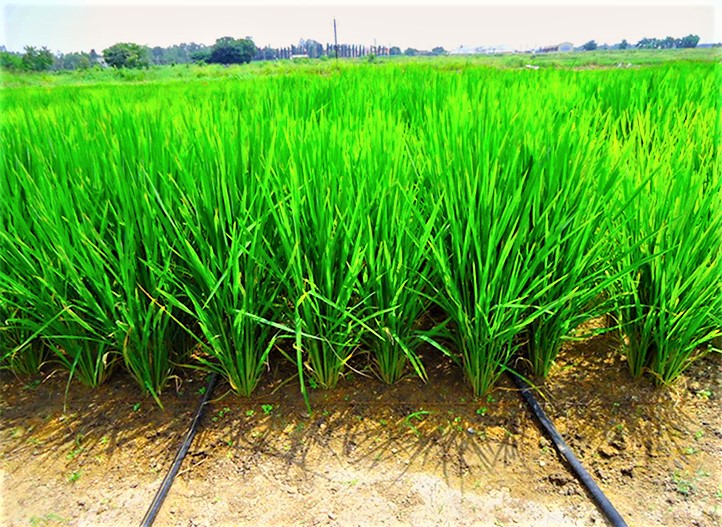Posted On: May 30, 2024
Posted By: KSNM DRIP

Paddy is the second most important crop globally, producing 715MT paddy (482 MT milled rice).
China is the largest producer with 210.1MT from 29.5 Mha, followed by India
producing 165.3 MT from 44.1 Mha. And rice is an important staple food for more
than 50 % of the world's population. There are many varieties of rice, but the cultivation process of all of them looks similar. Different irrigation systems are used to help paddy crops grow healthier and bring the best yield to the farmer. While traditionally grown in flooded fields, modern advancements have made alternative methods like drip irrigation increasingly viable. This article explores the benefits of adopting drip irrigation in rice cultivation, shedding light on its advantages over traditional flood irrigation methods.
Yes, with drip irrigation you can easily cultivate rice. While rice is traditionally grown in flooded fields, advancements in irrigation technology have made it possible to grow rice using alternative methods such as drip irrigation. Using drip irrigation brings a lot of benefits to your cultivation process.
For your rice cultivation, using drip irrigation provides a lot of advantages. Look at the advantages and make sure that, you change to KSNM drip irrigation today to enjoy all those benefits.
You can grow a larger number of crops with less water when compared with other irrigation methods.
With drip irrigation, you can save 50-61% water on your irrigation system.
It is easy to provide the necessary nutrients and fertilizers needed for your crops
Since water is applied directly to the roots there is less chance of weeds to grow, as all the nutrients are absorbed by the crops.
You can avoid waterlogging that happens with traditional irrigation methods.
Drip irrigation systems are easily adaptable to various types of soil, and sizes of fields and on any topography, making it the perfect option for rice cultivation.
There is a reduction in manual labor works like weeding and herbicide application saving you a lot of money.
Using drip irrigation prevents soil erosion that occurs due to traditional irrigation methods like flood irrigation.
The amount of energy required to operate a drip irrigation system is comparatively less than using other irrigation methods.
With these advantages, you are sure to have a bountiful paddy harvest by just changing to a drip irrigation system. By choosing KSNM Drip as your drip irrigation partners, you can make a good paddy harvest. If you are not satisfied with it, go to What are the Reasons to Invest in Drip Irrigation System? And get solid reasons to invest in the drip irrigation system.
The best type of irrigation for rice cultivation would be drip irrigation when you consider water scarcity and the growing costs for laborers. There are also other advantages to using drip irrigation than the traditional flood irrigation which you have read before. Here are some numerical facts that will give you more reasons to choose drip irrigation over flood irrigation for rice cultivation.
Drip irrigation is a highly efficient method of watering crops, including rice, that delivers water directly to the roots of plants, minimizing waste and maximizing water usage. Here's a simple procedure to help you effectively utilize drip irrigation in your rice cultivation process:
Before installing a drip irrigation system, assess your rice field's layout, including its size, shape, and topography.
Determine the water requirements of your rice crop based on its growth stage, soil type, and environmental conditions.
Choose the appropriate drip irrigation equipment, including drip tapes, emitters, filters, and pressure regulators, based on your field's specifications and water requirements.
Begin by laying out the main water supply line along the perimeter of your rice field, ensuring it is connected to a reliable water source such as a pump or reservoir.
Install sub-main lines perpendicular to the main line, dividing the field into manageable irrigation zones.
Lay drip tapes or lines within each irrigation zone, spacing them evenly and ensuring proper alignment with the rice rows.
Secure the drip lines in place using stakes or anchors to prevent movement or damage during irrigation and cultivation activities.
Regularly monitor the drip irrigation system for any leaks, clogs, or malfunctions, and promptly address any issues to ensure optimal performance.
Adjust the watering schedule and duration as needed to meet the changing water needs of your rice crop throughout its growth cycle.
Conduct periodic maintenance tasks, such as cleaning filters, flushing drip lines, and replacing worn-out components, to keep the system operating efficiently.
Keep accurate records of water usage, irrigation schedules, and crop performance to assess the effectiveness of the drip irrigation system and make informed decisions for future seasons.
During the rice harvest, carefully remove any drip irrigation equipment from the field to avoid damage to machinery and ensure a smooth harvesting process.
After harvest, clean and store drip lines and other components properly to prevent deterioration and prolong their lifespan for future use.
Conduct a thorough evaluation of the drip irrigation system's performance and effectiveness at the end of the growing season, noting any areas for improvement or adjustments for the next crop cycle.
By following these steps, you can effectively implement and manage a drip irrigation system in your rice cultivation process, optimizing water usage, enhancing crop yields, and promoting sustainable agriculture practices. If you are not clear on the things needed for setting up a drip irrigation system.
The adoption of drip irrigation in rice cultivation offers numerous advantages, making it a highly suitable choice for modern agricultural practices. With significant water savings, reduced labor costs, and improved crop yields, drip irrigation emerges as a sustainable and efficient solution for rice farmers worldwide. By embracing drip irrigation technology, farmers can optimize resource usage, minimize environmental impact, and ensure a bountiful harvest, paving the way for a prosperous future in rice cultivation.